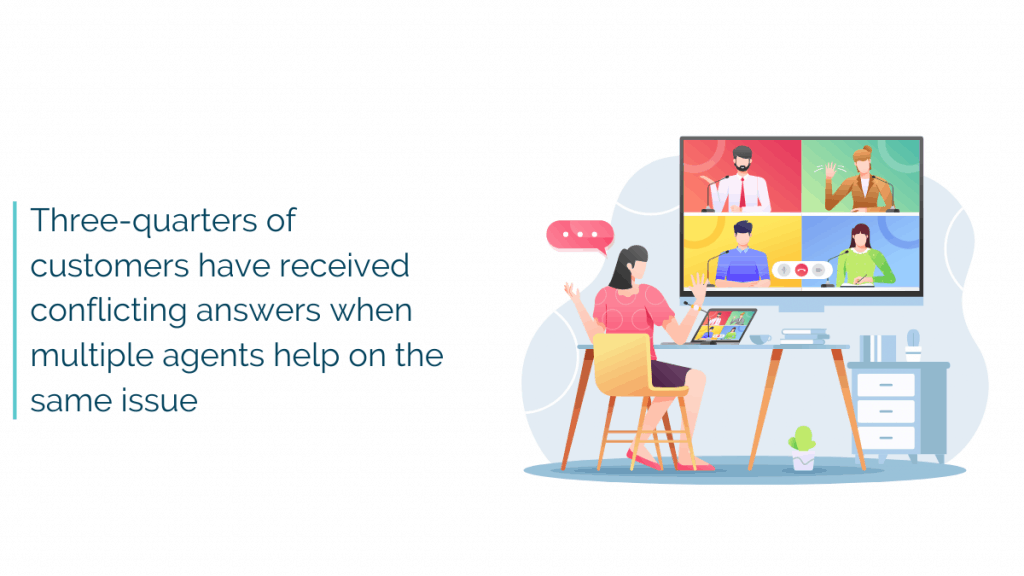In this post:
- Why balancing AHT and service matters
- What is AHT?
- 14 tips to cut Average Handling Time
- #1 Improve your call routing
- #2 Gather customer information automatically
- #3 Show customer information on screen
- #4 Improve your data collection
- #5 Offer omnichannel support
- #6 Train agents thoroughly
- #7 Provide agents with support
- #8 Create more effective processes!
- #9 Keep your agents up to date
- #10 Monitor new hires
- #11 Hire more broadly… or go virtual!
- #12 Encourage active listening
- #13 Stop highlighting average handle time
- #14 Reduce wrap time
So I was sitting in a local restaurant with my wife.
Three courses had been and gone; now it was time for a strong coffee and the bill.
The waiter brought over both and we settled up.
Ten seconds later I realized he was hovering nearby, eyeing us.
“He wants the table” my wife whispered. “Drink up.”
That might have been my cue to obstinately drink as slowly as possible… but instead, we knocked back the coffee and left.
I mean, who wants to finish their meal under observation?
That waiter’s impatience didn’t ruin date night. But I’m not sure we’ll go back to the restaurant.
Why am I talking about date night in an article on AHT?
Here’s the point: customer service is a balancing act.
Yes, Average Handling Time (AHT) has a direct relationship with cost. You need to keep a lid on it or your entire budget will vanish (just like restaurants need to flip tables)
However… businesses that focus single-mindedly on AHT tend to wreck their customer experience.
They also create expensive problems for themselves, like low First Contact Resolution.
Customers want speedy service. But they don’t want rushed or incomplete service.
So if you ‘want the table’… it makes sense to let your customer finish their coffee!
Quick refresher – what is AHT?
AHT is the amount of time your call center typically takes to “handle” a call.
The timer starts when a customer reaches an agent and it keeps ticking until that agent completes after-call work.
The length of your conversations is a vital piece of information to gather. You can even aim to reduce AHT – so long as you don’t do that by rushing customers.
The good news is that there are plenty of ways for both you and your customers to win.

14 Average Handling Time tips for busy contact centers
#1 Improve your call routing
The task of cutting AHT starts before your customer even reaches an agent.
If you can route them to the best person for their issue, your team will be well placed to provide quick service.
Personalized call routing will help enormously.
Some businesses seem to think personalization is a giant challenge, but it doesn’t have to be at all.
With No-Code tools it’s easy to integrate your CRM, IVR, and helpdesk software.
That puts your customer data to work and means you can route customers on things like their previous issues or current tickets.

#2 Gather customer information automatically
Before you go ahead and route the caller to an agent, you can find out quite a bit about what they need.
An IVR – even a basic, DTMF system – can narrow down the options a little.
Modern solutions, powered by conversational AI, go much further and can record highly detailed information.
(Really good AI deployments can actually solve certain issues themselves… but that’s another article!)
#3 Show customer information on screen
The second your customer reaches an agent, the timer starts ticking.
Remember; we want to speed up the interaction by reducing wasted time and not by rushing the conversation!
It makes sense to start the conversation by showing the agent essential customer information.
The way this works is simple.
That integration we looked at in point #1 means that customer data from your CRM is accessible from the word go.
You just need a tiny automation that brings up that data for the agent.
The customer doesn’t need to introduce themselves or give you their life story; your agent knows all the important stuff and gets right into the solution.
#4 Improve your data collection
Data collection – it’s always the least thrilling yet most important challenge to overcome.
If you want to slash your handling times, data is where you start – but that only works if you have data in the first place.
Collecting customer data during a call is the key to ensuring that every subsequent call is also as short as possible.
So – make sure your agents can easily access your CRM to add notes during a call and be sure to store call logs and post-call contact within the CRM *automatically*.
#5 Offer omnichannel support
Great customer service nowadays is omnichannel or bust.
The good news for you is that omnichannel support is also very likely to reduce your AHT.
Consider the customer who tries to use a chatbot for help, then decides to call your contact center for more information.
Arming the agent with that chatbot conversation will provide them with in-depth detail about the issue so far.
Hey presto – you’ll save masses of time because the customer doesn’t have to start from scratch.
#6 Train agents thoroughly
Experienced agents who know your product, customers and processes are best placed to provide fast and effective service.
Some contact centers ask agents who achieve low AHT to pass on tips to their peers.
That’s a great idea… so long as those agents also do well in CSat and other quality metrics.
If you have agents achieving super-fast calls because they know your systems and shortcuts really well, great! Spread that around!
But if you’ve got agents who are just talking too fast, that’s less useful.
You can approach this from the other side of course – why are agents with long handling times slower?
Either way, make sure you don’t fall into this classic trap… never incentivise agents to cut call length.
It’s the quickest way to wreck your service standards.

#7 Provide agents with support
Even the best agents need help at times, especially when dealing with unusual or complex issues.
A well-maintained knowledge base (with detailed product information) is one of the best investments you’ll ever make.
Agents can use it to find quick answers to customer issues. Plus, they can browse in their downtime to make good use of any spare moments.
Or, do what T-Mobile did and use communication software to help agents collaborate on problems.
#8 Create more effective processes!
Sometimes you need to look beyond how agents use your processes… and look at the processes themselves.
Under one quarter of contact centers collaborate fully in the design of their own processes.
Be honest… doesn’t that explain a lot?
If you take a long hard look at your contact handling processes there’s a good chance that you’ll find half a dozen ways to shorten calls organically.
Of course, you need the ability to simplify the way new processes are designed and implemented.
That is exactly why contact centers are turning to No-Code platforms for quick turnaround of new processes!
#9 Keep your agents up to date
I can’t count the number of times I’ve spoken to agents who were unaware of the new product launch… the major marketing campaign… the redesigned process.
Around 60% of failed First Contact Resolution attempts are due to an agent’s inability to access the right information.
This is an integration challenge, but it’s also related to internal communication.
How exactly are you communicating changes within your business to the people on the front lines?
Do you have a defined approach, and if so… is it really working?
#10 Monitor new hires
New hires without contact center experience are slower than experienced employees.
… And there’s not much you can do about that!
But you can speed up their progress.
If you’re after a tech solution, your best agent productivity tool might be Natural Language Understanding (NLU).
Some NLU use cases are pretty mind-blowing! It can anticipate the direction a call is going to take and suggest useful next actions, fast.
There’s always room for comprehensive training too.
It’s often a tough call, but consider putting in one or two few extra weeks with agents before they’re handling live queries.
Every dollar you spend in training is twenty you’ll save down the line.
(No, I don’t have a stat to back that up… but it sounds good doesn’t it?)
#11 Hire more broadly… or go virtual!
Bad hiring is the root cause for a good number of issues in the contact center.
You can’t really select for agents who talk fast… but you can hire for problem solving skills.
People who solve puzzles and challenges quickly in an interview setting can do the same with a customer.
And really, that’s most of the job!
But what if your pool of candidates is too small?
In that case, you might need to increase your virtual footprint.
Businesses adopting a virtual call center model see better agent performance in:
- Escalated calls (down)
- Agent turnover (down)
- Enquiries converted to orders (up!)
This used to be a pretty scary proposition for contact centers.
But after Covid? It’s practically the norm already!
#12 Encourage active listening
Agents can only solve problems once they understand the issue.
The quicker they gain this knowledge, the shorter the call.
So – encourage your agents to listen actively. This is an effective way to better understand customer problems.
Read our guide to find more about how to encourage active listening at your contact center.
#13 Stop highlighting average handle time
Sound counterintuitive?
Well, research from the Harvard Business Review has shown that when service leaders *stopped* highlighting AHT, handling time went… down.
So what’s going on here?
The theory goes that when agents focus on solving problems rather than shortening calls, they find better paths to solutions.
Service is always better this way… and surprisingly, it’s faster too!
#14 Reduce wrap time
Wrap-up time / After-Call Work (ACW) impacts handling time.
The more you can reduce this, the lower your handle time will be.
This is another occasion when your focus needs to be on getting rid of wasted time – not customer talk time.
One option is to show agents how to complete some ACW during the call.
This is a good time-saver as long as it doesn’t affect service.
An all-round strong approach to call center automation helps too; a lot of that boring data entry is fully automatable if you have the right tool.
You can easily do this by using a No-Code platform to integrate the various tools you use at your contact center.
And the uses of no-code go far beyond reducing Average Handling Time. You can use it for virtual queuing, automated callbacks, outbound calls, preemptive support, and more.





